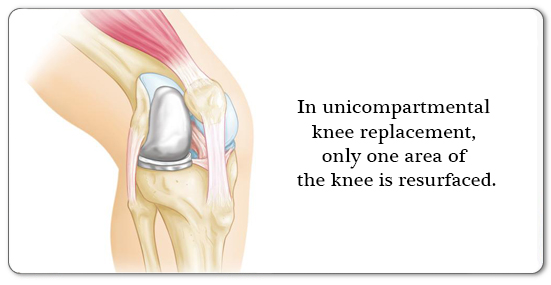Partial Knee Replacement
A partial knee replacement is an alternative to total knee replacement for some patients with osteoarthritis of the knee. During knee replacement surgery, damaged bone and cartilage is resurfaced with metal and plastic components.
In a partial knee replacement only a portion of the knee is resurfaced. This procedure is an alternative to total knee replacement for patients whose disease is limited to just one area of the knee. This surgery can be done when the damage is confined to a particular compartment of the knee.
Because a partial knee replacement is done through a smaller incision, patients usually spend less time in the hospital and return to normal activities sooner than total knee replacement patients.
In the past, partial knee replacement was reserved for older patients who were involved in few activities. Now, partial knee replacement is often preferred in the younger population as their recovery is quicker and often with much less pain. About 5% to 6% of patients with arthritic knees are estimated to be eligible for partial knee replacement.
In a partial knee replacement, only the damaged part of the knee cartilage is replaced with prosthesis.

Advantages of Partial Knee Replacement
Multiple studies show that a majority of patients who are appropriate candidates for the procedure have good results with unicompartmental knee replacement. Compared to total knee replacement, partial knee replacement better preserves range of motion and knee function because it preserves healthy tissue and bone in the knee. For these reasons, patients tend to be more satisfied with partial knee replacement compared with total knee replacement. They are still candidates for total knee replacement should they ever need it in the future. There is also less blood loss during surgery, and knee motion recovers faster with partial knee replacement.
The advantages of partial knee replacement over total knee replacement include:
- Quicker recovery
- Less pain after surgery
- Less blood loss
Also, because the bone, cartilage, and ligaments in the healthy parts of the knee are kept, many patients report that a unicompartmental knee replacement feels more natural than a total knee replacement. A unicompartmental knee may also bend better.
Disadvantages of Partial Knee Replacement
The disadvantages of partial knee replacement compared with total knee replacement include:
- An infection at the surgical site is possible. Blood clots are a risk as are injuries to a blood vessel or a nerve. These complications are quite rare.
- Slightly less predictable pain relief
- You may experience some knee joint stiffness.
- Potential need for more surgery. For example, a total knee replacement may be necessary in the future if arthritis develops in the parts of the knee that have not been replaced.
- Late complications may include infection and a failure, loosening, or dislocation of the prosthesis as well as continued pain.